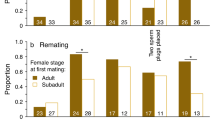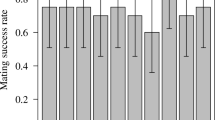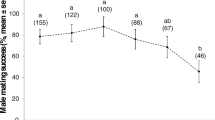Abstract
The adaptive significance of multiple matings for females is a matter of much controversy. In insects, supplying the female’s sperm reserves with portions of fresh spermatozoa may be the main function of multiple matings. This simple explanation may also be applied to other animals which produce large numbers of eggs over prolonged periods of time. We tested the fertility insurance hypothesis in Montandon’s newt (Triturus montandoni, Amphibia, Salamandridae). T. montandoni females are inseminated internally by spermatophores they have picked up, and subsequently lay eggs fertilized by spermatozoa released from the spermatheca. We compared the reproductive success of singly and multiply inseminated females of Montandon’s newt in the laboratory. Multiply inseminated females laid more eggs and had a lower percentage of non-developing eggs than females who mated only once. Our data suggest that remating increases the reproductive success of multiply inseminated females by replenishing sperm reserves in the spermatheca or by supplying females with fresh portions of spermatozoa with high fertilizing capacity.
Similar content being viewed by others
Author information
Authors and Affiliations
Additional information
Received: 7 January 2000 / Revised: 13 September 2000 / Accepted: 7 October 2000
Rights and permissions
About this article
Cite this article
Osikowski, A., Rafin´ski, J. Multiple insemination increases reproductive success of female Montandon’s newt (Triturus montandoni, Caudata, Salamandridae). Behav Ecol Sociobiol 49, 145–149 (2001). https://doi.org/10.1007/s002650000277
Issue Date:
DOI: https://doi.org/10.1007/s002650000277




